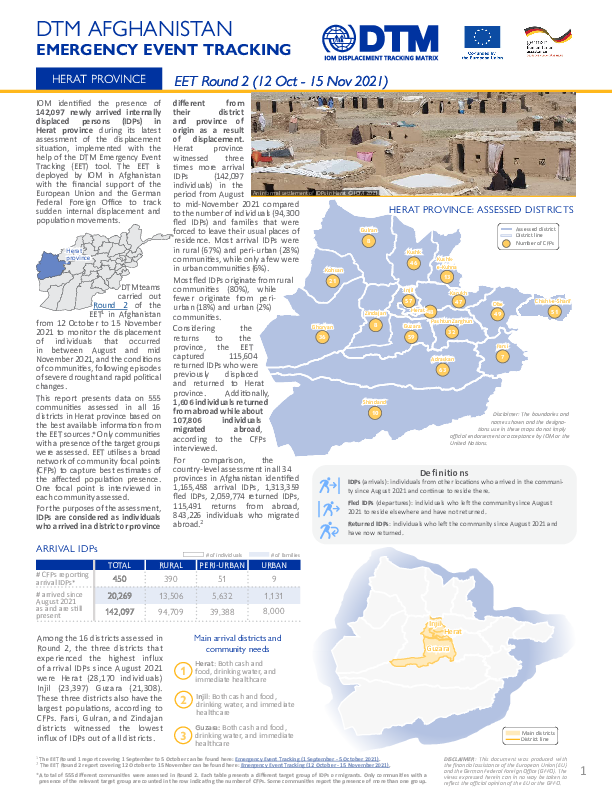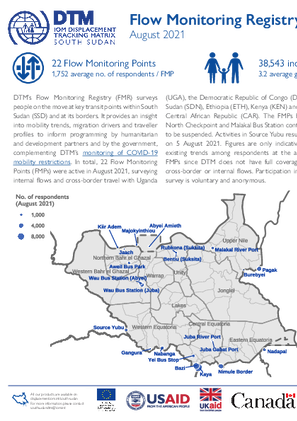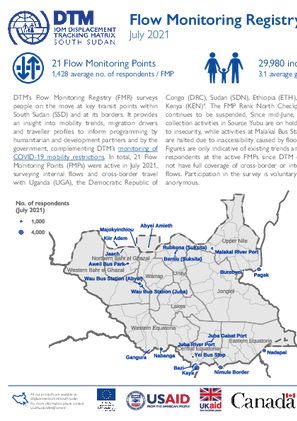-
Countries
-
Data and Analysis
-
Special Focus
-
Crisis Responses

Contact
DTM Yemen, iomyemendtm@iom.int
Language
English
Location
Yemen
Period Covered
Dec 05 2021
Dec 11 2021
Activity
- Rapid Emergency Registration
- Mobility Tracking
IOM Yemen DTM’s Rapid Displacement Tracking (RDT) tool collects data on numbers of households forced to flee on a daily basis from their locations of origin or displacement, allowing for regular reporting of new displacements in terms of numbers, geography, and needs. It also tracks Returnees who returned to their location of origin.
From 01 January 2021 to 11 December 2021, IOM Yemen DTM estimates that 22,925 households (HH) (137,550 Individuals) have experienced displacement at least once.
Since the beginning of 2021, DTM also identified 4,404 displaced households who left their locations of displacement and either moved back to their place of origin or another location.
Between 05 and 11 December 2021, IOM Yemen DTM tracked 961 households (5,766 individuals) displaced at least once. The top three governorates and districts where people moved into/within are:
- Marib (607 HH) – Marib (323 HH), Marib City (284 HH) districts. Most displacements in the governorate were internal.
- Al Hodeidah (119 HH) – Al Khukhah (80 HH), Hays (39 HH) districts. Most displacements in the governorate were internal.
- Taiz (95 HH) – Mawza (41 HH), Al Makha (20 HH), Salah (14 HH) districts. Most displacements in the governorate originated from Taiz and Al Hodeidah.
Most displacements resulted from the increased conflict in the following governorates and districts.
- Marib (604 HH) – Marib (534 HH), Al Jubah (53 HH), Harib (10 HH) districts.
- Al Hodeidah (156 HH) – Hays (90 HH), Jabal Ras (28 HH), Al Jarrahi (23 HH) districts.
- Taiz (93 HH) – Maqbanah (71 HH), Sabir Al Mawadim (8 HH), At Taiziyah (3 HH) districts.
Some 162 HH displaced in the previous reporting period, which covered 28 November - 04 December 2021, in the governorates of Marib (76 HH), Taiz (53 HH), Al Hodeidah (18 HH), Aden (8 HH), Al Maharah (7 HH), were only identified in the current period and so, this figure has been added to the cumulative displacement total recorded from the beginning of the year.

Contact
DTM Afghanistan, DTMKabul@iom.int
Language
English
Location
Afghanistan
Period Covered
Oct 12 2021
Nov 15 2021
Activity
- Event Tracking
IOM identified the presence of 69,153 newly arrived Internally Displaced Persons (IDPs) in Kabul province during its latest assessment of the displacement situation, implemented with the help of the DTM Emergency Event Tracking (EET) tool. The EET is deployed by IOM in Afghanistan with the financial support of the European Union and the German Federal Foreign Office to track sudden internal displacement and population movements.
DTM teams carried out Round 2 of the EET1 in Afghanistan from 12 October to 15 November 2021 to monitor the displacement of individuals that occurred in between August and mid November 2021, and the conditions of communities, following episodes of severe drought and rapid political changes. This report presents data on 493 communities assessed in 14 (out of the 15) districts in Kabul province based on the best available information from the EET sources.* Only communities with a presence of the target groups were assessed. EET utilises a broad network of community focal points (CFPs) to capture best estimates of the affected population presence. One focal point is interviewed in each community assessed.

Contact
DTM Afghanistan, DTMKabul@iom.int
Language
English
Location
Afghanistan
Period Covered
Oct 12 2021
Nov 15 2021
Activity
- Event Tracking
IOM identified the presence of 142,097 newly arrived internally displaced persons (IDPs) in Herat province during its latest assessment of the displacement situation, implemented with the help of the DTM Emergency Event Tracking (EET) tool. The EET is deployed by IOM in Afghanistan with the financial support of the European Union and the German Federal Foreign Office to track sudden internal displacement and population movements.
DTM teams carried out Round 2 of the EET1 in Afghanistan from 12 October to 15 November 2021 to monitor the displacement of individuals that occurred in between August and mid November 2021, and the conditions of communities, following episodes of severe drought and rapid political changes.
This report presents data on 555 communities assessed in all 16 districts in Herat province based on the best available information from the EET sources.* Only communities with a presence of the target groups were assessed. EET utilises a broad network of community focal points (CFPs) to capture best estimates of the affected population presence. One focal point is interviewed in each community assessed.

Contact
DTM Djibouti, DTMDjibouti@iom.int
Language
English
Location
Djibouti
Period Covered
Nov 01 2021
Nov 30 2021
Activity
- Survey
- Flow Monitoring Survey
- Flow Monitoring
- Migrants presence
This dashboard presents the main migration trends observed in Djibouti in November 2021. It aims to provide an overview of the main mobility trends in Djibouti, through both quantitative and qualitative analyses, obtained from several data collection tools developed by IOM Djibouti.
This dashboard includes:
- A monthly update on the key data obtained through the Flow Monitoring Registry (FMR) at the 10 active Flow Monitoring Points (FMPs) in Djibouti;
- Key data on spontaneous returns from Yemen and movements observed between Djibouti and Ethiopia;
- Anmonthly update on the profile, vulnerabilities, migratory experience and intentions of the migrants surveyed through the Flow Monitoring Surveys (FMS);
- An update on the presence of migrants stranded in Djibouti.

Contact
DTM Djibouti, DTMDjibouti@iom.int
Language
French
Location
Djibouti
Period Covered
Nov 01 2021
Nov 30 2021
Activity
- Survey
- Flow Monitoring Survey
- Flow Monitoring
- Migrants presence
Ce tableau de bord présente les principales tendances migratoires observées à Djibouti en novembre 2021. Il vise à fournir une vue d'ensemble des principales dynamiques migratoires au niveau de Djibouti, en présentant des analyses à la fois quantitatives et qualitatives obtenues à travers plusieurs outils de collectes de données développées par l'OIM Djibouti.
Ce tableau de bord comprend:
- Une mise à jour mensuelle des principales données obtenues à travers l’enregistrement des flux aux 10 points de suivi des flux (FMP) actifs à Djibouti;
- Des données clés sur les retours spontanés du Yémen ainsi que sur les mouvements entre Djibouti et l'Éthiopie;
- Une mise à jour mensuelle sur les profils, vulnérabilités, parcours migratoires et intentions des personnes interrogées à travers les enquêtes individuelles (FMS);
- Une mise à jour sur la présence des migrants bloqués à Djibouti.
The COVID-19 outbreak has restricted global mobility, whilst heightening the risk of exploitation of vulnerable populations. This report provides a snapshot of the COVID-19 epidemiological situation and mobility restrictions, and of the current migration trends along the Eastern Corridor migration route, in addition to an analysis of the impact that movement restrictions have had in Djibouti, Ethiopia, Somalia, and Yemen. Moreover, it provides information on the main protection concerns for migrants and assistance provided, and COVID-19 risk mitigation measures. This report utilizes data collected through IOM’s Displacement Tracking Matrix (DTM) Flow Monitoring Points (FMPs), Migration Response Centres (MRCs),1 Assisted Voluntary Return (AVR) data, as well as anecdotal information provided by IOM team members working in the region.

Contact
DTM South Sudan, SouthSudanDTM@iom.int
Language
English
Location
South Sudan
Period Covered
Sep 01 2021
Sep 30 2021
Activity
- Flow Monitoring
DTM’s Flow Monitoring Registry (FMR) surveys people on the move at key transit points within South Sudan (SSD) and at its borders. It provides an insight into mobility trends, migration drivers and traveller profiles to inform programming by humanitarian and development partners and by the government, complementing DTM’s monitoring of COVID-19 mobility restrictions. In total, 23 Flow Monitoring Points (FMPs) were active in September 2021, surveying internal flows and cross-border travel with Uganda (UGA), the Democratic Republic of Congo (DRC), Sudan (SDN), Ethiopia (ETH), Kenya (KEN) and the Central African Republic (CAR). The FMPs Renk North Checkpoint and Malakal Bus Station continue to be suspended. Figures are only indicative of existing trends among respondents at the active FMPs since DTM does not have full coverage of cross-border or internal flows. Participation in the survey is voluntary and anonymous.
Please click here to access a summary dataset.
Contact
SouthSudanDTM@iom.int
Location
South Sudan
Activity
- Flow Monitoring Survey
- Flow Monitoring
Period Covered
Sep 01 2021 -Sep 30 2021
Flow monitoring aims to derive quantitative estimates of the flow of individuals through specific locations and to collect information about the profile, intentions and needs of the people moving and to quantify highly mobile populations by providing a picture of complex mobility dynamics.
Population Groups
Survey Methodology
Unit of Analysis Or Observation
Type of Survey or Assessment
Keywords
Geographical Scope
Administrative boundaries with available data
The current dataset covers the following administrative boundaries

Contact
DTM South Sudan, SouthSudanDTM@iom.int
Language
English
Location
South Sudan
Period Covered
Aug 01 2021
Aug 31 2021
Activity
- Flow Monitoring
DTM’s Flow Monitoring Registry (FMR) surveys people on the move at key transit points within South Sudan (SSD) and at its borders. It provides an insight into mobility trends, migration drivers and traveller profiles to inform programming by humanitarian and development partners and by the government, complementing DTM’s monitoring of COVID-19 mobility restrictions. In total, 22 Flow Monitoring Points (FMPs) were active in August 2021, surveying internal flows and cross-border travel with Uganda (UGA), the Democratic Republic of Congo (DRC), Sudan (SDN), Ethiopia (ETH), Kenya (KEN) and the Central African Republic (CAR). The FMPs Renk North Checkpoint and Malakal Bus Station continue to be suspended. Activities in Source Yubu resumed on 5 August 2021. Figures are only indicative of existing trends among respondents at the active FMPs since DTM does not have full coverage of cross-border or internal flows. Participation in the survey is voluntary and anonymous.
Please click here to access a summary dataset.

Contact
DTM South Sudan, SouthSudanDTM@iom.int
Language
English
Location
South Sudan
Period Covered
Jul 01 2021
Jul 31 2021
Activity
- Flow Monitoring
DTM’s Flow Monitoring Registry (FMR) surveys people on the move at key transit points within South Sudan (SSD) and at its borders. It provides an insight into mobility trends, migration drivers and traveller profiles to inform programming by humanitarian and development partners and by the government, complementing DTM’s monitoring of COVID-19 mobility restrictions. In total, 21 Flow Monitoring Points (FMPs) were active in July 2021, surveying internal flows and cross-border travel with Uganda (UGA), the Democratic Republic of Congo (DRC), Sudan (SDN), Ethiopia (ETH), and Kenya (KEN)4. The FMP Renk North Checkpoint continues to be suspended. Since mid-June, data collection activities in Source Yubu are on hold due to insecurity, while activities at Malakal Bus Station are halted due to inaccessibility caused by flooding. Figures are only indicative of existing trends among respondents at the active FMPs since DTM does not have full coverage of cross-border or internal flows. Participation in the survey is voluntary and anonymous.
Please click here to access a summary dataset.
